Business Law: Sources, Role of Government, Impact on Business, Formation of Organizations
VerifiedAdded on 2023/06/15
|12
|4425
|417
AI Summary
This report covers the sources of business law, the role of government in making laws, and the impact of company, employment, and contract law on businesses. It also elaborates on the formation of different types of business organizations.
Contribute Materials
Your contribution can guide someone’s learning journey. Share your
documents today.
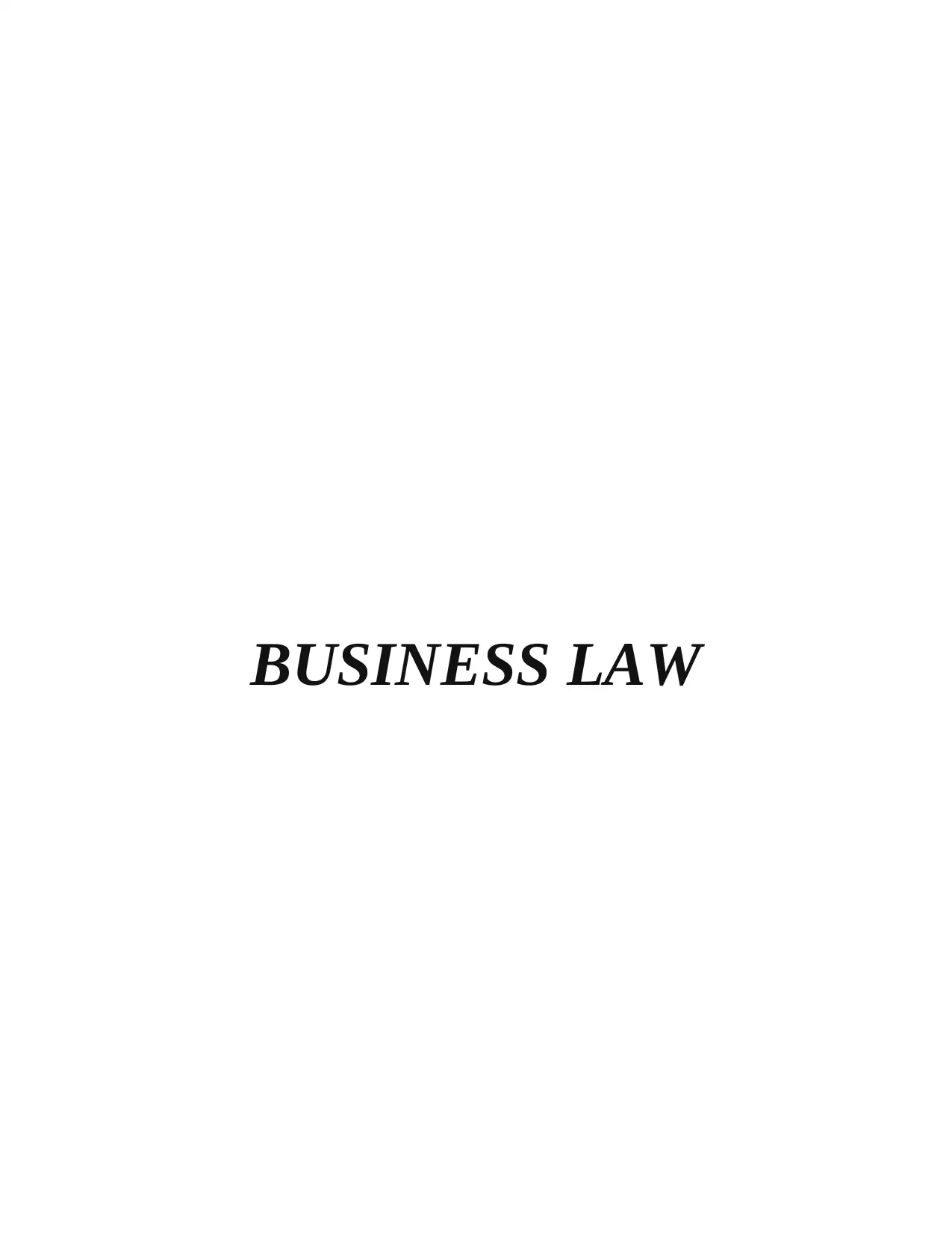
BUSINESS LAW
Secure Best Marks with AI Grader
Need help grading? Try our AI Grader for instant feedback on your assignments.
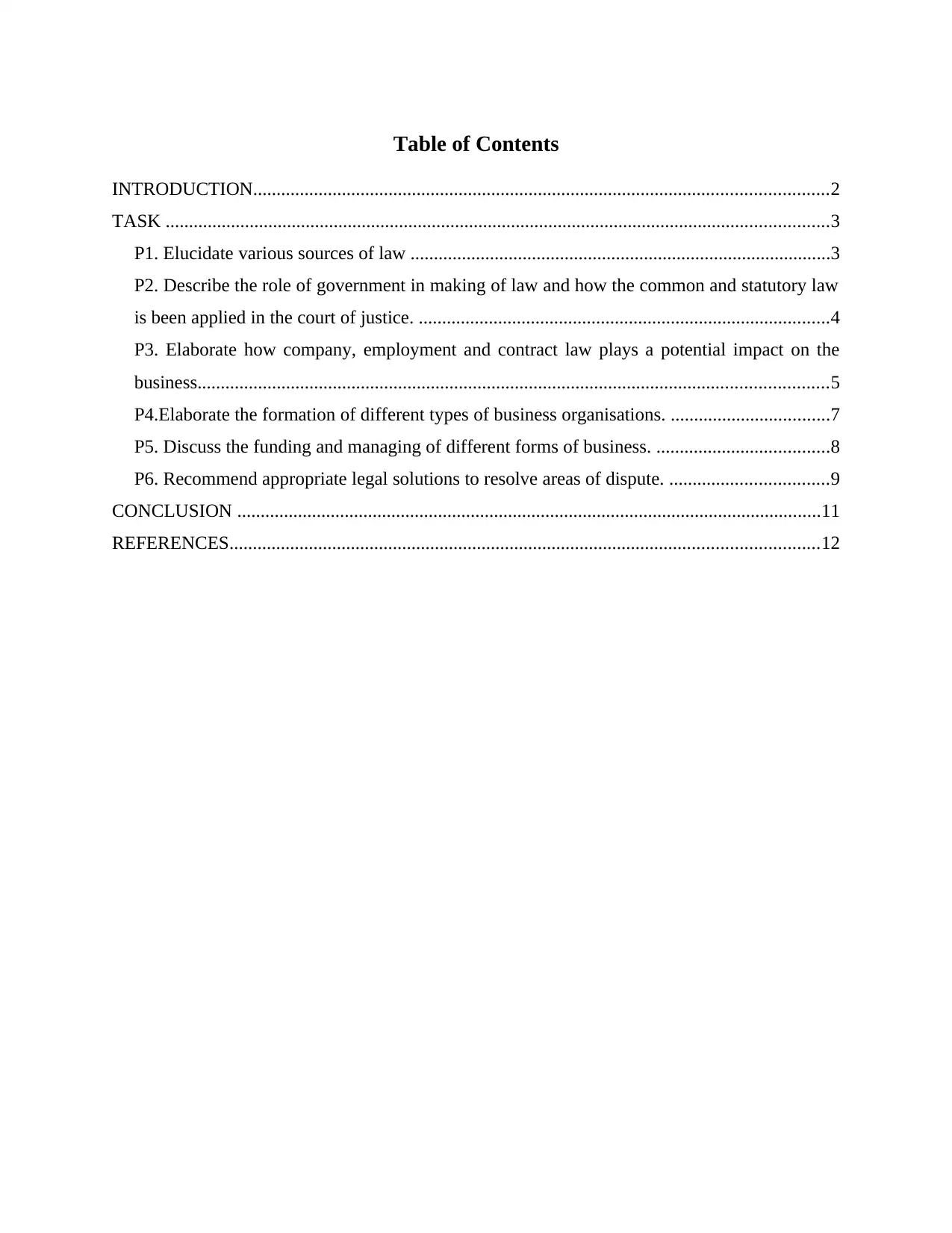
Table of Contents
INTRODUCTION...........................................................................................................................2
TASK ..............................................................................................................................................3
P1. Elucidate various sources of law ..........................................................................................3
P2. Describe the role of government in making of law and how the common and statutory law
is been applied in the court of justice. ........................................................................................4
P3. Elaborate how company, employment and contract law plays a potential impact on the
business.......................................................................................................................................5
P4.Elaborate the formation of different types of business organisations. ..................................7
P5. Discuss the funding and managing of different forms of business. .....................................8
P6. Recommend appropriate legal solutions to resolve areas of dispute. ..................................9
CONCLUSION .............................................................................................................................11
REFERENCES..............................................................................................................................12
INTRODUCTION...........................................................................................................................2
TASK ..............................................................................................................................................3
P1. Elucidate various sources of law ..........................................................................................3
P2. Describe the role of government in making of law and how the common and statutory law
is been applied in the court of justice. ........................................................................................4
P3. Elaborate how company, employment and contract law plays a potential impact on the
business.......................................................................................................................................5
P4.Elaborate the formation of different types of business organisations. ..................................7
P5. Discuss the funding and managing of different forms of business. .....................................8
P6. Recommend appropriate legal solutions to resolve areas of dispute. ..................................9
CONCLUSION .............................................................................................................................11
REFERENCES..............................................................................................................................12
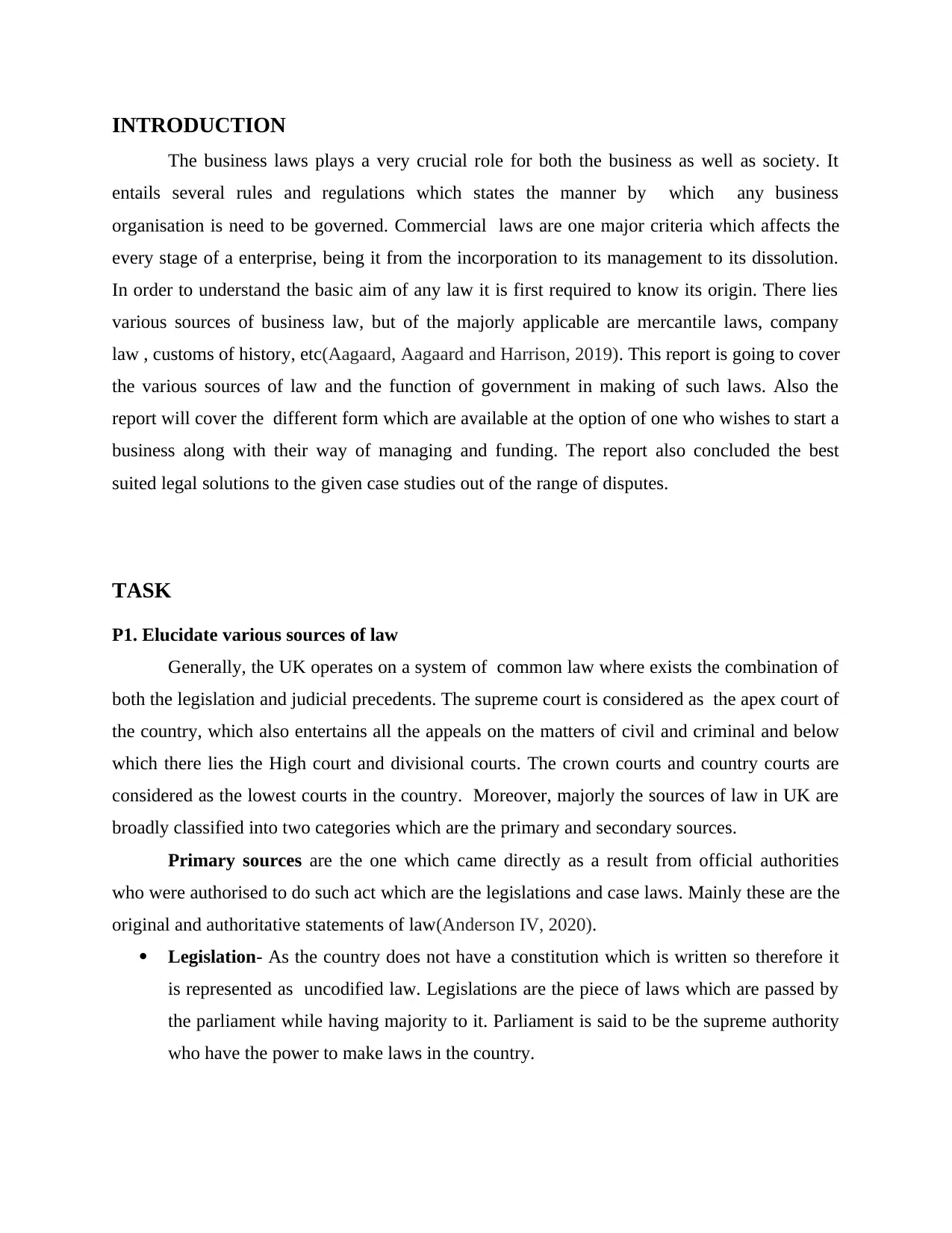
INTRODUCTION
The business laws plays a very crucial role for both the business as well as society. It
entails several rules and regulations which states the manner by which any business
organisation is need to be governed. Commercial laws are one major criteria which affects the
every stage of a enterprise, being it from the incorporation to its management to its dissolution.
In order to understand the basic aim of any law it is first required to know its origin. There lies
various sources of business law, but of the majorly applicable are mercantile laws, company
law , customs of history, etc(Aagaard, Aagaard and Harrison, 2019). This report is going to cover
the various sources of law and the function of government in making of such laws. Also the
report will cover the different form which are available at the option of one who wishes to start a
business along with their way of managing and funding. The report also concluded the best
suited legal solutions to the given case studies out of the range of disputes.
TASK
P1. Elucidate various sources of law
Generally, the UK operates on a system of common law where exists the combination of
both the legislation and judicial precedents. The supreme court is considered as the apex court of
the country, which also entertains all the appeals on the matters of civil and criminal and below
which there lies the High court and divisional courts. The crown courts and country courts are
considered as the lowest courts in the country. Moreover, majorly the sources of law in UK are
broadly classified into two categories which are the primary and secondary sources.
Primary sources are the one which came directly as a result from official authorities
who were authorised to do such act which are the legislations and case laws. Mainly these are the
original and authoritative statements of law(Anderson IV, 2020).
Legislation- As the country does not have a constitution which is written so therefore it
is represented as uncodified law. Legislations are the piece of laws which are passed by
the parliament while having majority to it. Parliament is said to be the supreme authority
who have the power to make laws in the country.
The business laws plays a very crucial role for both the business as well as society. It
entails several rules and regulations which states the manner by which any business
organisation is need to be governed. Commercial laws are one major criteria which affects the
every stage of a enterprise, being it from the incorporation to its management to its dissolution.
In order to understand the basic aim of any law it is first required to know its origin. There lies
various sources of business law, but of the majorly applicable are mercantile laws, company
law , customs of history, etc(Aagaard, Aagaard and Harrison, 2019). This report is going to cover
the various sources of law and the function of government in making of such laws. Also the
report will cover the different form which are available at the option of one who wishes to start a
business along with their way of managing and funding. The report also concluded the best
suited legal solutions to the given case studies out of the range of disputes.
TASK
P1. Elucidate various sources of law
Generally, the UK operates on a system of common law where exists the combination of
both the legislation and judicial precedents. The supreme court is considered as the apex court of
the country, which also entertains all the appeals on the matters of civil and criminal and below
which there lies the High court and divisional courts. The crown courts and country courts are
considered as the lowest courts in the country. Moreover, majorly the sources of law in UK are
broadly classified into two categories which are the primary and secondary sources.
Primary sources are the one which came directly as a result from official authorities
who were authorised to do such act which are the legislations and case laws. Mainly these are the
original and authoritative statements of law(Anderson IV, 2020).
Legislation- As the country does not have a constitution which is written so therefore it
is represented as uncodified law. Legislations are the piece of laws which are passed by
the parliament while having majority to it. Parliament is said to be the supreme authority
who have the power to make laws in the country.
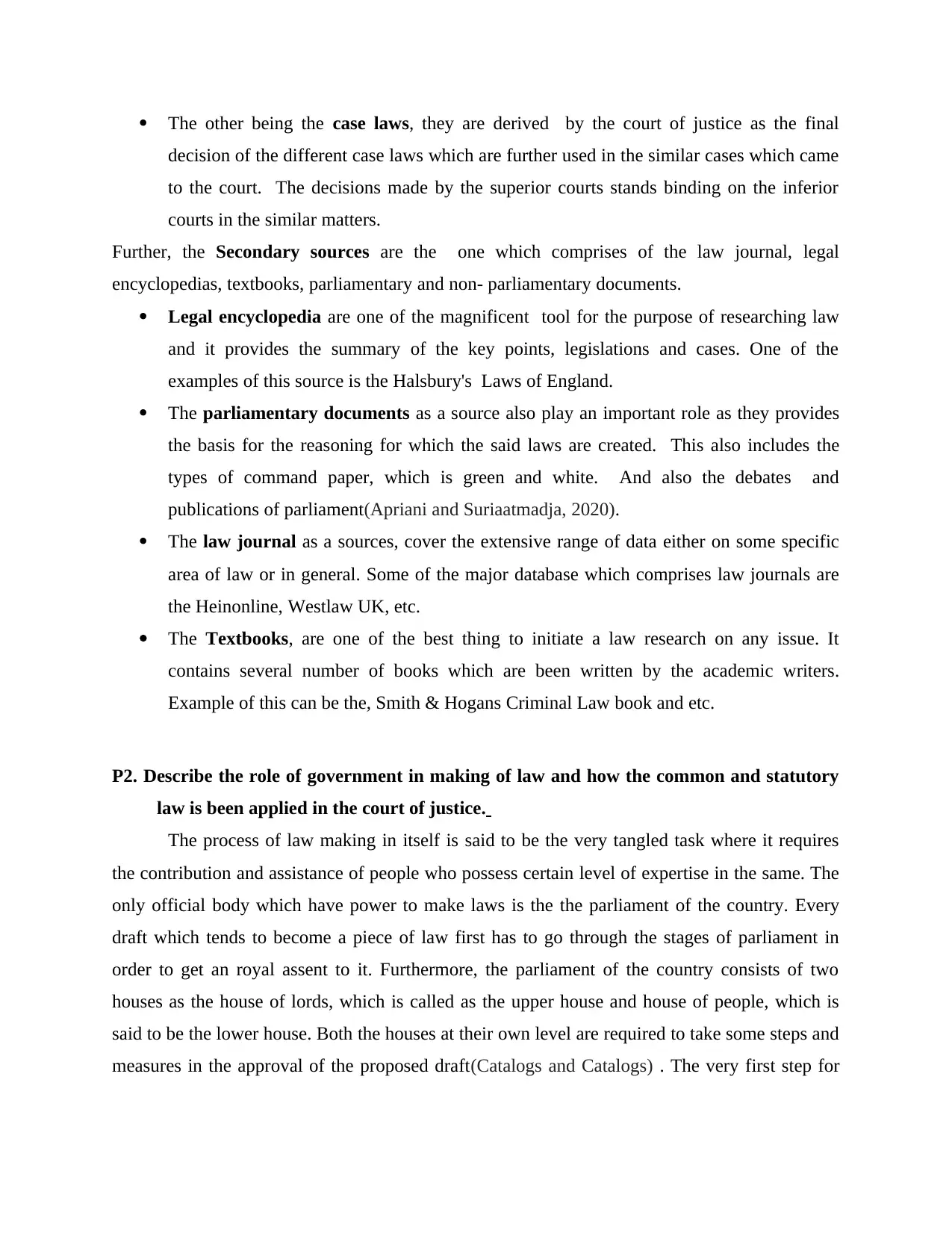
The other being the case laws, they are derived by the court of justice as the final
decision of the different case laws which are further used in the similar cases which came
to the court. The decisions made by the superior courts stands binding on the inferior
courts in the similar matters.
Further, the Secondary sources are the one which comprises of the law journal, legal
encyclopedias, textbooks, parliamentary and non- parliamentary documents.
Legal encyclopedia are one of the magnificent tool for the purpose of researching law
and it provides the summary of the key points, legislations and cases. One of the
examples of this source is the Halsbury's Laws of England.
The parliamentary documents as a source also play an important role as they provides
the basis for the reasoning for which the said laws are created. This also includes the
types of command paper, which is green and white. And also the debates and
publications of parliament(Apriani and Suriaatmadja, 2020).
The law journal as a sources, cover the extensive range of data either on some specific
area of law or in general. Some of the major database which comprises law journals are
the Heinonline, Westlaw UK, etc.
The Textbooks, are one of the best thing to initiate a law research on any issue. It
contains several number of books which are been written by the academic writers.
Example of this can be the, Smith & Hogans Criminal Law book and etc.
P2. Describe the role of government in making of law and how the common and statutory
law is been applied in the court of justice.
The process of law making in itself is said to be the very tangled task where it requires
the contribution and assistance of people who possess certain level of expertise in the same. The
only official body which have power to make laws is the the parliament of the country. Every
draft which tends to become a piece of law first has to go through the stages of parliament in
order to get an royal assent to it. Furthermore, the parliament of the country consists of two
houses as the house of lords, which is called as the upper house and house of people, which is
said to be the lower house. Both the houses at their own level are required to take some steps and
measures in the approval of the proposed draft(Catalogs and Catalogs) . The very first step for
decision of the different case laws which are further used in the similar cases which came
to the court. The decisions made by the superior courts stands binding on the inferior
courts in the similar matters.
Further, the Secondary sources are the one which comprises of the law journal, legal
encyclopedias, textbooks, parliamentary and non- parliamentary documents.
Legal encyclopedia are one of the magnificent tool for the purpose of researching law
and it provides the summary of the key points, legislations and cases. One of the
examples of this source is the Halsbury's Laws of England.
The parliamentary documents as a source also play an important role as they provides
the basis for the reasoning for which the said laws are created. This also includes the
types of command paper, which is green and white. And also the debates and
publications of parliament(Apriani and Suriaatmadja, 2020).
The law journal as a sources, cover the extensive range of data either on some specific
area of law or in general. Some of the major database which comprises law journals are
the Heinonline, Westlaw UK, etc.
The Textbooks, are one of the best thing to initiate a law research on any issue. It
contains several number of books which are been written by the academic writers.
Example of this can be the, Smith & Hogans Criminal Law book and etc.
P2. Describe the role of government in making of law and how the common and statutory
law is been applied in the court of justice.
The process of law making in itself is said to be the very tangled task where it requires
the contribution and assistance of people who possess certain level of expertise in the same. The
only official body which have power to make laws is the the parliament of the country. Every
draft which tends to become a piece of law first has to go through the stages of parliament in
order to get an royal assent to it. Furthermore, the parliament of the country consists of two
houses as the house of lords, which is called as the upper house and house of people, which is
said to be the lower house. Both the houses at their own level are required to take some steps and
measures in the approval of the proposed draft(Catalogs and Catalogs) . The very first step for
Paraphrase This Document
Need a fresh take? Get an instant paraphrase of this document with our AI Paraphraser
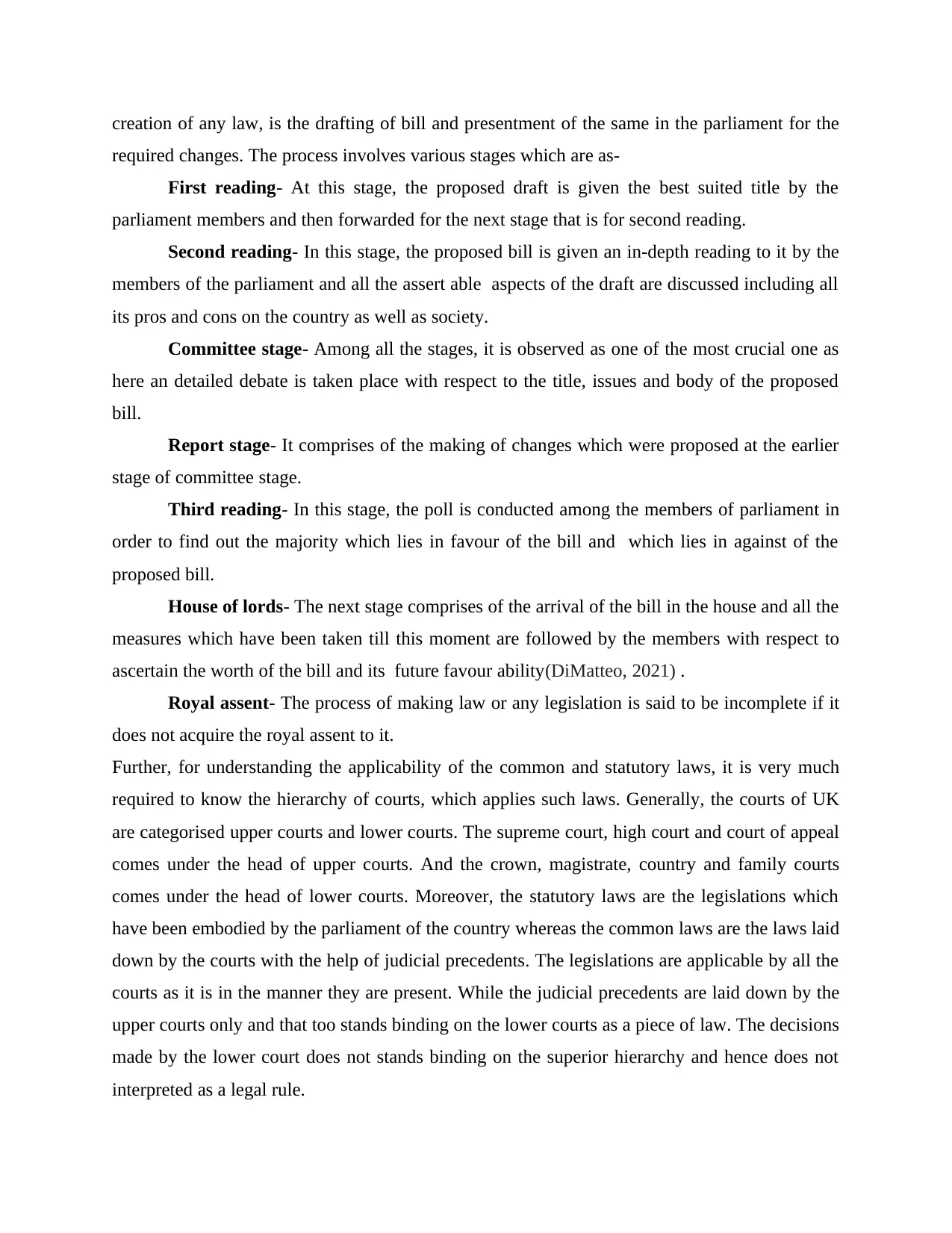
creation of any law, is the drafting of bill and presentment of the same in the parliament for the
required changes. The process involves various stages which are as-
First reading- At this stage, the proposed draft is given the best suited title by the
parliament members and then forwarded for the next stage that is for second reading.
Second reading- In this stage, the proposed bill is given an in-depth reading to it by the
members of the parliament and all the assert able aspects of the draft are discussed including all
its pros and cons on the country as well as society.
Committee stage- Among all the stages, it is observed as one of the most crucial one as
here an detailed debate is taken place with respect to the title, issues and body of the proposed
bill.
Report stage- It comprises of the making of changes which were proposed at the earlier
stage of committee stage.
Third reading- In this stage, the poll is conducted among the members of parliament in
order to find out the majority which lies in favour of the bill and which lies in against of the
proposed bill.
House of lords- The next stage comprises of the arrival of the bill in the house and all the
measures which have been taken till this moment are followed by the members with respect to
ascertain the worth of the bill and its future favour ability(DiMatteo, 2021) .
Royal assent- The process of making law or any legislation is said to be incomplete if it
does not acquire the royal assent to it.
Further, for understanding the applicability of the common and statutory laws, it is very much
required to know the hierarchy of courts, which applies such laws. Generally, the courts of UK
are categorised upper courts and lower courts. The supreme court, high court and court of appeal
comes under the head of upper courts. And the crown, magistrate, country and family courts
comes under the head of lower courts. Moreover, the statutory laws are the legislations which
have been embodied by the parliament of the country whereas the common laws are the laws laid
down by the courts with the help of judicial precedents. The legislations are applicable by all the
courts as it is in the manner they are present. While the judicial precedents are laid down by the
upper courts only and that too stands binding on the lower courts as a piece of law. The decisions
made by the lower court does not stands binding on the superior hierarchy and hence does not
interpreted as a legal rule.
required changes. The process involves various stages which are as-
First reading- At this stage, the proposed draft is given the best suited title by the
parliament members and then forwarded for the next stage that is for second reading.
Second reading- In this stage, the proposed bill is given an in-depth reading to it by the
members of the parliament and all the assert able aspects of the draft are discussed including all
its pros and cons on the country as well as society.
Committee stage- Among all the stages, it is observed as one of the most crucial one as
here an detailed debate is taken place with respect to the title, issues and body of the proposed
bill.
Report stage- It comprises of the making of changes which were proposed at the earlier
stage of committee stage.
Third reading- In this stage, the poll is conducted among the members of parliament in
order to find out the majority which lies in favour of the bill and which lies in against of the
proposed bill.
House of lords- The next stage comprises of the arrival of the bill in the house and all the
measures which have been taken till this moment are followed by the members with respect to
ascertain the worth of the bill and its future favour ability(DiMatteo, 2021) .
Royal assent- The process of making law or any legislation is said to be incomplete if it
does not acquire the royal assent to it.
Further, for understanding the applicability of the common and statutory laws, it is very much
required to know the hierarchy of courts, which applies such laws. Generally, the courts of UK
are categorised upper courts and lower courts. The supreme court, high court and court of appeal
comes under the head of upper courts. And the crown, magistrate, country and family courts
comes under the head of lower courts. Moreover, the statutory laws are the legislations which
have been embodied by the parliament of the country whereas the common laws are the laws laid
down by the courts with the help of judicial precedents. The legislations are applicable by all the
courts as it is in the manner they are present. While the judicial precedents are laid down by the
upper courts only and that too stands binding on the lower courts as a piece of law. The decisions
made by the lower court does not stands binding on the superior hierarchy and hence does not
interpreted as a legal rule.
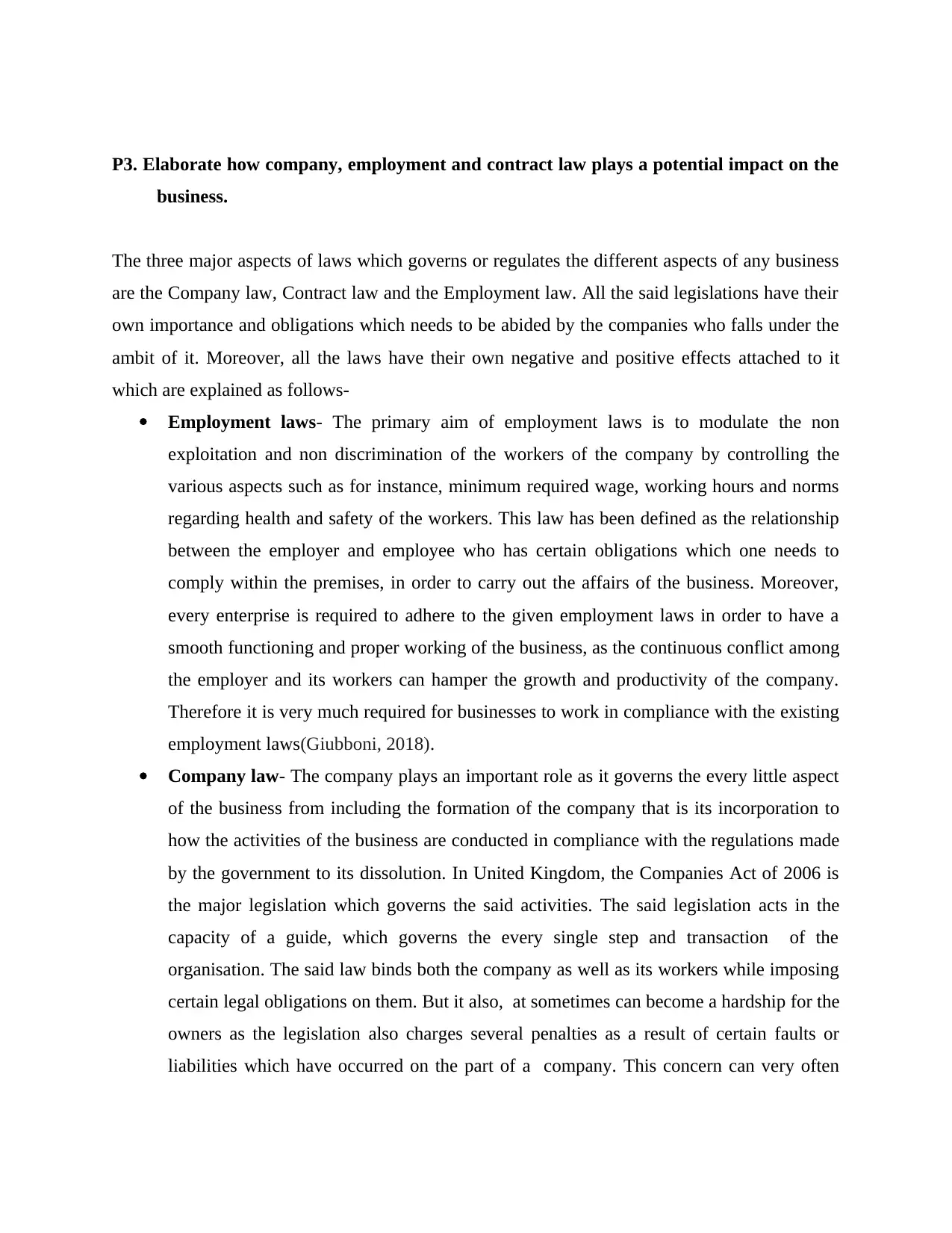
P3. Elaborate how company, employment and contract law plays a potential impact on the
business.
The three major aspects of laws which governs or regulates the different aspects of any business
are the Company law, Contract law and the Employment law. All the said legislations have their
own importance and obligations which needs to be abided by the companies who falls under the
ambit of it. Moreover, all the laws have their own negative and positive effects attached to it
which are explained as follows-
Employment laws- The primary aim of employment laws is to modulate the non
exploitation and non discrimination of the workers of the company by controlling the
various aspects such as for instance, minimum required wage, working hours and norms
regarding health and safety of the workers. This law has been defined as the relationship
between the employer and employee who has certain obligations which one needs to
comply within the premises, in order to carry out the affairs of the business. Moreover,
every enterprise is required to adhere to the given employment laws in order to have a
smooth functioning and proper working of the business, as the continuous conflict among
the employer and its workers can hamper the growth and productivity of the company.
Therefore it is very much required for businesses to work in compliance with the existing
employment laws(Giubboni, 2018).
Company law- The company plays an important role as it governs the every little aspect
of the business from including the formation of the company that is its incorporation to
how the activities of the business are conducted in compliance with the regulations made
by the government to its dissolution. In United Kingdom, the Companies Act of 2006 is
the major legislation which governs the said activities. The said legislation acts in the
capacity of a guide, which governs the every single step and transaction of the
organisation. The said law binds both the company as well as its workers while imposing
certain legal obligations on them. But it also, at sometimes can become a hardship for the
owners as the legislation also charges several penalties as a result of certain faults or
liabilities which have occurred on the part of a company. This concern can very often
business.
The three major aspects of laws which governs or regulates the different aspects of any business
are the Company law, Contract law and the Employment law. All the said legislations have their
own importance and obligations which needs to be abided by the companies who falls under the
ambit of it. Moreover, all the laws have their own negative and positive effects attached to it
which are explained as follows-
Employment laws- The primary aim of employment laws is to modulate the non
exploitation and non discrimination of the workers of the company by controlling the
various aspects such as for instance, minimum required wage, working hours and norms
regarding health and safety of the workers. This law has been defined as the relationship
between the employer and employee who has certain obligations which one needs to
comply within the premises, in order to carry out the affairs of the business. Moreover,
every enterprise is required to adhere to the given employment laws in order to have a
smooth functioning and proper working of the business, as the continuous conflict among
the employer and its workers can hamper the growth and productivity of the company.
Therefore it is very much required for businesses to work in compliance with the existing
employment laws(Giubboni, 2018).
Company law- The company plays an important role as it governs the every little aspect
of the business from including the formation of the company that is its incorporation to
how the activities of the business are conducted in compliance with the regulations made
by the government to its dissolution. In United Kingdom, the Companies Act of 2006 is
the major legislation which governs the said activities. The said legislation acts in the
capacity of a guide, which governs the every single step and transaction of the
organisation. The said law binds both the company as well as its workers while imposing
certain legal obligations on them. But it also, at sometimes can become a hardship for the
owners as the legislation also charges several penalties as a result of certain faults or
liabilities which have occurred on the part of a company. This concern can very often
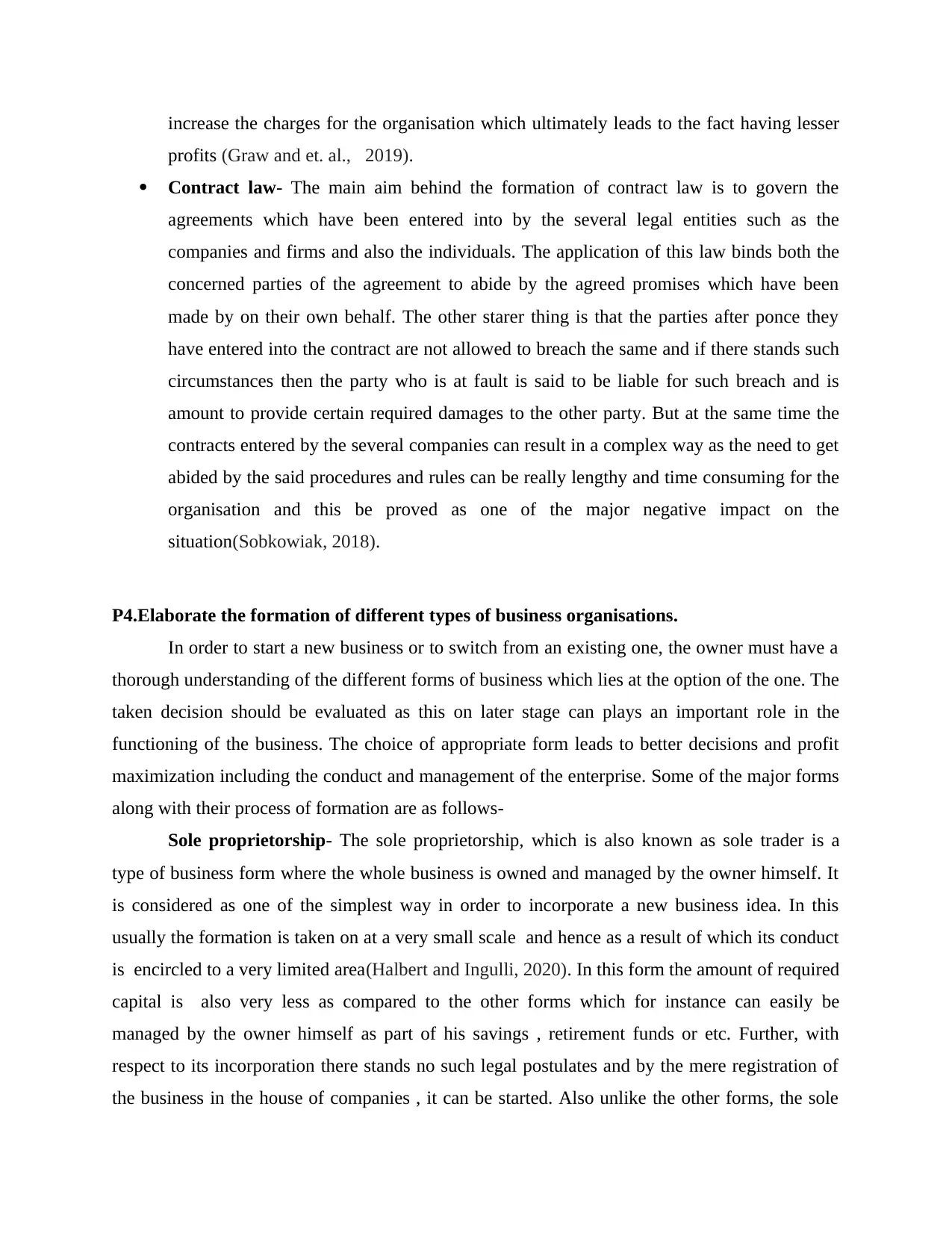
increase the charges for the organisation which ultimately leads to the fact having lesser
profits (Graw and et. al., 2019).
Contract law- The main aim behind the formation of contract law is to govern the
agreements which have been entered into by the several legal entities such as the
companies and firms and also the individuals. The application of this law binds both the
concerned parties of the agreement to abide by the agreed promises which have been
made by on their own behalf. The other starer thing is that the parties after ponce they
have entered into the contract are not allowed to breach the same and if there stands such
circumstances then the party who is at fault is said to be liable for such breach and is
amount to provide certain required damages to the other party. But at the same time the
contracts entered by the several companies can result in a complex way as the need to get
abided by the said procedures and rules can be really lengthy and time consuming for the
organisation and this be proved as one of the major negative impact on the
situation(Sobkowiak, 2018).
P4.Elaborate the formation of different types of business organisations.
In order to start a new business or to switch from an existing one, the owner must have a
thorough understanding of the different forms of business which lies at the option of the one. The
taken decision should be evaluated as this on later stage can plays an important role in the
functioning of the business. The choice of appropriate form leads to better decisions and profit
maximization including the conduct and management of the enterprise. Some of the major forms
along with their process of formation are as follows-
Sole proprietorship- The sole proprietorship, which is also known as sole trader is a
type of business form where the whole business is owned and managed by the owner himself. It
is considered as one of the simplest way in order to incorporate a new business idea. In this
usually the formation is taken on at a very small scale and hence as a result of which its conduct
is encircled to a very limited area(Halbert and Ingulli, 2020). In this form the amount of required
capital is also very less as compared to the other forms which for instance can easily be
managed by the owner himself as part of his savings , retirement funds or etc. Further, with
respect to its incorporation there stands no such legal postulates and by the mere registration of
the business in the house of companies , it can be started. Also unlike the other forms, the sole
profits (Graw and et. al., 2019).
Contract law- The main aim behind the formation of contract law is to govern the
agreements which have been entered into by the several legal entities such as the
companies and firms and also the individuals. The application of this law binds both the
concerned parties of the agreement to abide by the agreed promises which have been
made by on their own behalf. The other starer thing is that the parties after ponce they
have entered into the contract are not allowed to breach the same and if there stands such
circumstances then the party who is at fault is said to be liable for such breach and is
amount to provide certain required damages to the other party. But at the same time the
contracts entered by the several companies can result in a complex way as the need to get
abided by the said procedures and rules can be really lengthy and time consuming for the
organisation and this be proved as one of the major negative impact on the
situation(Sobkowiak, 2018).
P4.Elaborate the formation of different types of business organisations.
In order to start a new business or to switch from an existing one, the owner must have a
thorough understanding of the different forms of business which lies at the option of the one. The
taken decision should be evaluated as this on later stage can plays an important role in the
functioning of the business. The choice of appropriate form leads to better decisions and profit
maximization including the conduct and management of the enterprise. Some of the major forms
along with their process of formation are as follows-
Sole proprietorship- The sole proprietorship, which is also known as sole trader is a
type of business form where the whole business is owned and managed by the owner himself. It
is considered as one of the simplest way in order to incorporate a new business idea. In this
usually the formation is taken on at a very small scale and hence as a result of which its conduct
is encircled to a very limited area(Halbert and Ingulli, 2020). In this form the amount of required
capital is also very less as compared to the other forms which for instance can easily be
managed by the owner himself as part of his savings , retirement funds or etc. Further, with
respect to its incorporation there stands no such legal postulates and by the mere registration of
the business in the house of companies , it can be started. Also unlike the other forms, the sole
Secure Best Marks with AI Grader
Need help grading? Try our AI Grader for instant feedback on your assignments.
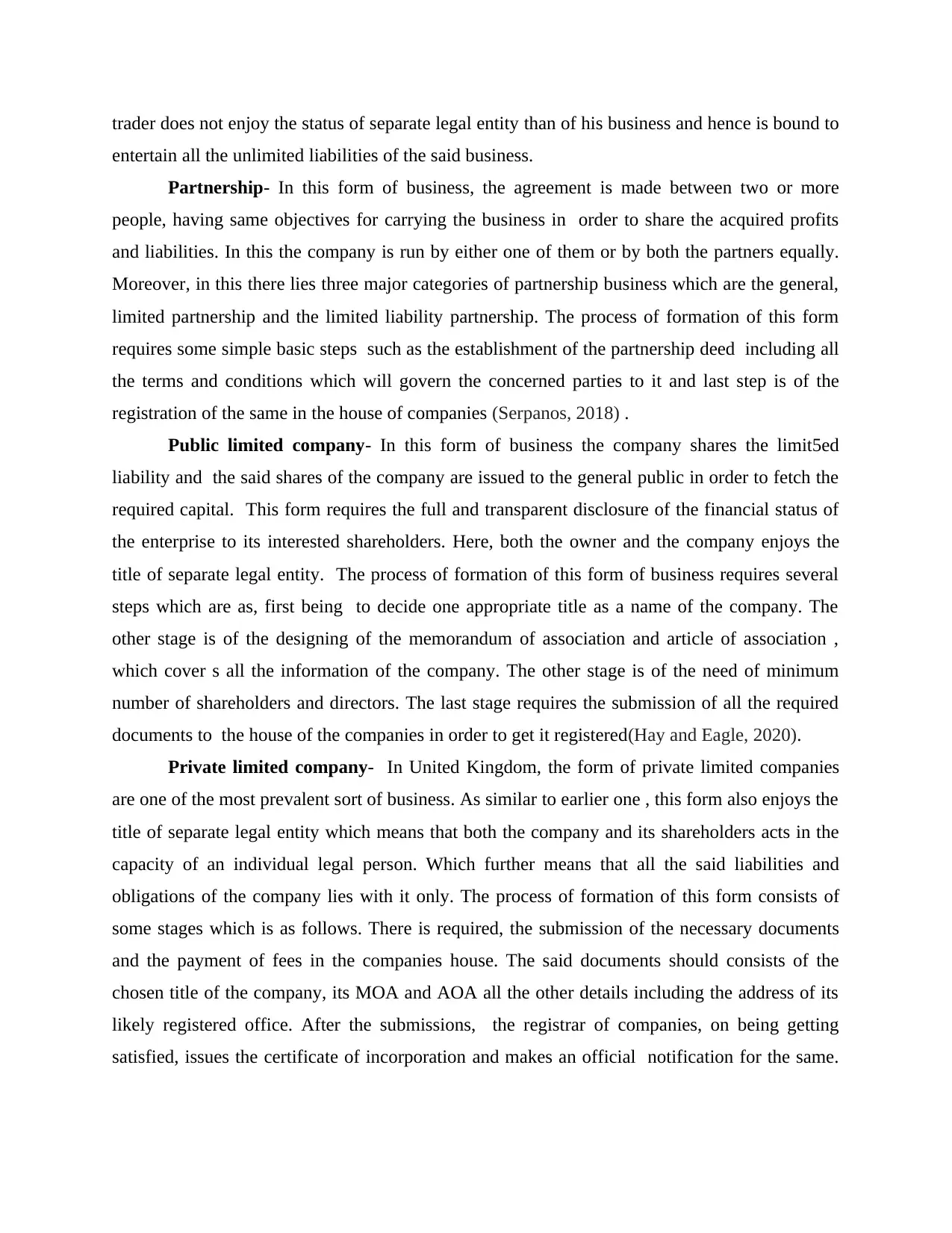
trader does not enjoy the status of separate legal entity than of his business and hence is bound to
entertain all the unlimited liabilities of the said business.
Partnership- In this form of business, the agreement is made between two or more
people, having same objectives for carrying the business in order to share the acquired profits
and liabilities. In this the company is run by either one of them or by both the partners equally.
Moreover, in this there lies three major categories of partnership business which are the general,
limited partnership and the limited liability partnership. The process of formation of this form
requires some simple basic steps such as the establishment of the partnership deed including all
the terms and conditions which will govern the concerned parties to it and last step is of the
registration of the same in the house of companies (Serpanos, 2018) .
Public limited company- In this form of business the company shares the limit5ed
liability and the said shares of the company are issued to the general public in order to fetch the
required capital. This form requires the full and transparent disclosure of the financial status of
the enterprise to its interested shareholders. Here, both the owner and the company enjoys the
title of separate legal entity. The process of formation of this form of business requires several
steps which are as, first being to decide one appropriate title as a name of the company. The
other stage is of the designing of the memorandum of association and article of association ,
which cover s all the information of the company. The other stage is of the need of minimum
number of shareholders and directors. The last stage requires the submission of all the required
documents to the house of the companies in order to get it registered(Hay and Eagle, 2020).
Private limited company- In United Kingdom, the form of private limited companies
are one of the most prevalent sort of business. As similar to earlier one , this form also enjoys the
title of separate legal entity which means that both the company and its shareholders acts in the
capacity of an individual legal person. Which further means that all the said liabilities and
obligations of the company lies with it only. The process of formation of this form consists of
some stages which is as follows. There is required, the submission of the necessary documents
and the payment of fees in the companies house. The said documents should consists of the
chosen title of the company, its MOA and AOA all the other details including the address of its
likely registered office. After the submissions, the registrar of companies, on being getting
satisfied, issues the certificate of incorporation and makes an official notification for the same.
entertain all the unlimited liabilities of the said business.
Partnership- In this form of business, the agreement is made between two or more
people, having same objectives for carrying the business in order to share the acquired profits
and liabilities. In this the company is run by either one of them or by both the partners equally.
Moreover, in this there lies three major categories of partnership business which are the general,
limited partnership and the limited liability partnership. The process of formation of this form
requires some simple basic steps such as the establishment of the partnership deed including all
the terms and conditions which will govern the concerned parties to it and last step is of the
registration of the same in the house of companies (Serpanos, 2018) .
Public limited company- In this form of business the company shares the limit5ed
liability and the said shares of the company are issued to the general public in order to fetch the
required capital. This form requires the full and transparent disclosure of the financial status of
the enterprise to its interested shareholders. Here, both the owner and the company enjoys the
title of separate legal entity. The process of formation of this form of business requires several
steps which are as, first being to decide one appropriate title as a name of the company. The
other stage is of the designing of the memorandum of association and article of association ,
which cover s all the information of the company. The other stage is of the need of minimum
number of shareholders and directors. The last stage requires the submission of all the required
documents to the house of the companies in order to get it registered(Hay and Eagle, 2020).
Private limited company- In United Kingdom, the form of private limited companies
are one of the most prevalent sort of business. As similar to earlier one , this form also enjoys the
title of separate legal entity which means that both the company and its shareholders acts in the
capacity of an individual legal person. Which further means that all the said liabilities and
obligations of the company lies with it only. The process of formation of this form consists of
some stages which is as follows. There is required, the submission of the necessary documents
and the payment of fees in the companies house. The said documents should consists of the
chosen title of the company, its MOA and AOA all the other details including the address of its
likely registered office. After the submissions, the registrar of companies, on being getting
satisfied, issues the certificate of incorporation and makes an official notification for the same.
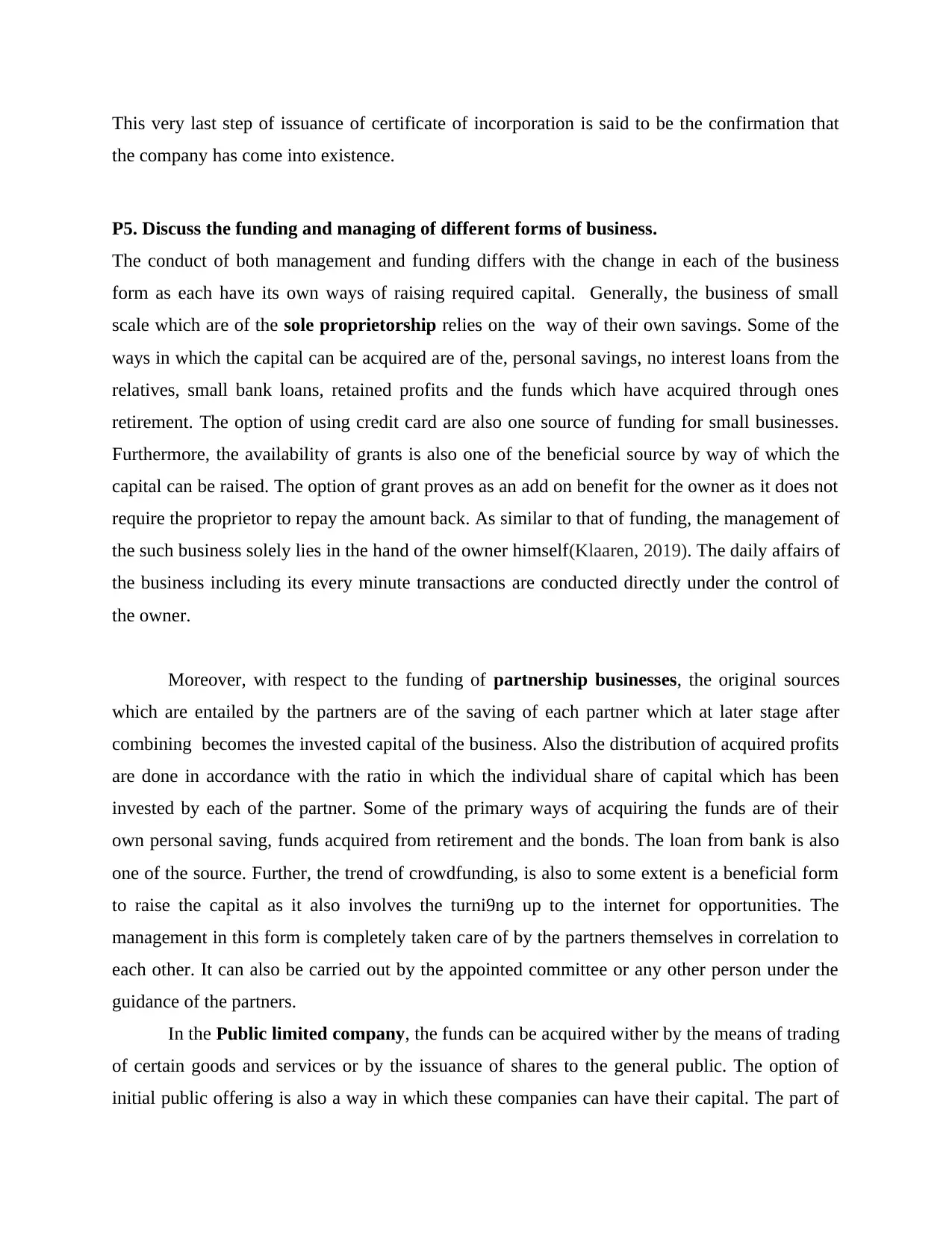
This very last step of issuance of certificate of incorporation is said to be the confirmation that
the company has come into existence.
P5. Discuss the funding and managing of different forms of business.
The conduct of both management and funding differs with the change in each of the business
form as each have its own ways of raising required capital. Generally, the business of small
scale which are of the sole proprietorship relies on the way of their own savings. Some of the
ways in which the capital can be acquired are of the, personal savings, no interest loans from the
relatives, small bank loans, retained profits and the funds which have acquired through ones
retirement. The option of using credit card are also one source of funding for small businesses.
Furthermore, the availability of grants is also one of the beneficial source by way of which the
capital can be raised. The option of grant proves as an add on benefit for the owner as it does not
require the proprietor to repay the amount back. As similar to that of funding, the management of
the such business solely lies in the hand of the owner himself(Klaaren, 2019). The daily affairs of
the business including its every minute transactions are conducted directly under the control of
the owner.
Moreover, with respect to the funding of partnership businesses, the original sources
which are entailed by the partners are of the saving of each partner which at later stage after
combining becomes the invested capital of the business. Also the distribution of acquired profits
are done in accordance with the ratio in which the individual share of capital which has been
invested by each of the partner. Some of the primary ways of acquiring the funds are of their
own personal saving, funds acquired from retirement and the bonds. The loan from bank is also
one of the source. Further, the trend of crowdfunding, is also to some extent is a beneficial form
to raise the capital as it also involves the turni9ng up to the internet for opportunities. The
management in this form is completely taken care of by the partners themselves in correlation to
each other. It can also be carried out by the appointed committee or any other person under the
guidance of the partners.
In the Public limited company, the funds can be acquired wither by the means of trading
of certain goods and services or by the issuance of shares to the general public. The option of
initial public offering is also a way in which these companies can have their capital. The part of
the company has come into existence.
P5. Discuss the funding and managing of different forms of business.
The conduct of both management and funding differs with the change in each of the business
form as each have its own ways of raising required capital. Generally, the business of small
scale which are of the sole proprietorship relies on the way of their own savings. Some of the
ways in which the capital can be acquired are of the, personal savings, no interest loans from the
relatives, small bank loans, retained profits and the funds which have acquired through ones
retirement. The option of using credit card are also one source of funding for small businesses.
Furthermore, the availability of grants is also one of the beneficial source by way of which the
capital can be raised. The option of grant proves as an add on benefit for the owner as it does not
require the proprietor to repay the amount back. As similar to that of funding, the management of
the such business solely lies in the hand of the owner himself(Klaaren, 2019). The daily affairs of
the business including its every minute transactions are conducted directly under the control of
the owner.
Moreover, with respect to the funding of partnership businesses, the original sources
which are entailed by the partners are of the saving of each partner which at later stage after
combining becomes the invested capital of the business. Also the distribution of acquired profits
are done in accordance with the ratio in which the individual share of capital which has been
invested by each of the partner. Some of the primary ways of acquiring the funds are of their
own personal saving, funds acquired from retirement and the bonds. The loan from bank is also
one of the source. Further, the trend of crowdfunding, is also to some extent is a beneficial form
to raise the capital as it also involves the turni9ng up to the internet for opportunities. The
management in this form is completely taken care of by the partners themselves in correlation to
each other. It can also be carried out by the appointed committee or any other person under the
guidance of the partners.
In the Public limited company, the funds can be acquired wither by the means of trading
of certain goods and services or by the issuance of shares to the general public. The option of
initial public offering is also a way in which these companies can have their capital. The part of
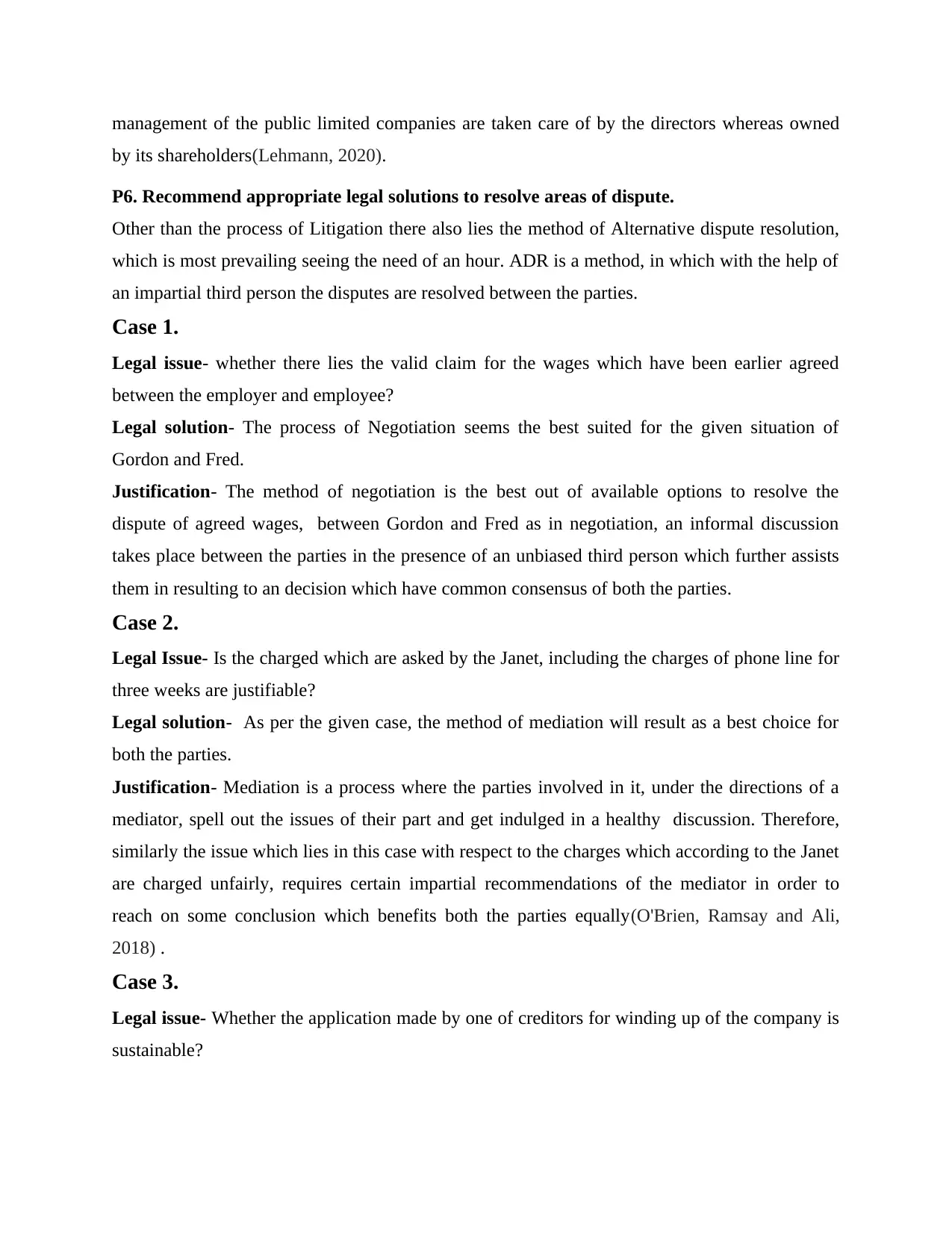
management of the public limited companies are taken care of by the directors whereas owned
by its shareholders(Lehmann, 2020).
P6. Recommend appropriate legal solutions to resolve areas of dispute.
Other than the process of Litigation there also lies the method of Alternative dispute resolution,
which is most prevailing seeing the need of an hour. ADR is a method, in which with the help of
an impartial third person the disputes are resolved between the parties.
Case 1.
Legal issue- whether there lies the valid claim for the wages which have been earlier agreed
between the employer and employee?
Legal solution- The process of Negotiation seems the best suited for the given situation of
Gordon and Fred.
Justification- The method of negotiation is the best out of available options to resolve the
dispute of agreed wages, between Gordon and Fred as in negotiation, an informal discussion
takes place between the parties in the presence of an unbiased third person which further assists
them in resulting to an decision which have common consensus of both the parties.
Case 2.
Legal Issue- Is the charged which are asked by the Janet, including the charges of phone line for
three weeks are justifiable?
Legal solution- As per the given case, the method of mediation will result as a best choice for
both the parties.
Justification- Mediation is a process where the parties involved in it, under the directions of a
mediator, spell out the issues of their part and get indulged in a healthy discussion. Therefore,
similarly the issue which lies in this case with respect to the charges which according to the Janet
are charged unfairly, requires certain impartial recommendations of the mediator in order to
reach on some conclusion which benefits both the parties equally(O'Brien, Ramsay and Ali,
2018) .
Case 3.
Legal issue- Whether the application made by one of creditors for winding up of the company is
sustainable?
by its shareholders(Lehmann, 2020).
P6. Recommend appropriate legal solutions to resolve areas of dispute.
Other than the process of Litigation there also lies the method of Alternative dispute resolution,
which is most prevailing seeing the need of an hour. ADR is a method, in which with the help of
an impartial third person the disputes are resolved between the parties.
Case 1.
Legal issue- whether there lies the valid claim for the wages which have been earlier agreed
between the employer and employee?
Legal solution- The process of Negotiation seems the best suited for the given situation of
Gordon and Fred.
Justification- The method of negotiation is the best out of available options to resolve the
dispute of agreed wages, between Gordon and Fred as in negotiation, an informal discussion
takes place between the parties in the presence of an unbiased third person which further assists
them in resulting to an decision which have common consensus of both the parties.
Case 2.
Legal Issue- Is the charged which are asked by the Janet, including the charges of phone line for
three weeks are justifiable?
Legal solution- As per the given case, the method of mediation will result as a best choice for
both the parties.
Justification- Mediation is a process where the parties involved in it, under the directions of a
mediator, spell out the issues of their part and get indulged in a healthy discussion. Therefore,
similarly the issue which lies in this case with respect to the charges which according to the Janet
are charged unfairly, requires certain impartial recommendations of the mediator in order to
reach on some conclusion which benefits both the parties equally(O'Brien, Ramsay and Ali,
2018) .
Case 3.
Legal issue- Whether the application made by one of creditors for winding up of the company is
sustainable?
Paraphrase This Document
Need a fresh take? Get an instant paraphrase of this document with our AI Paraphraser
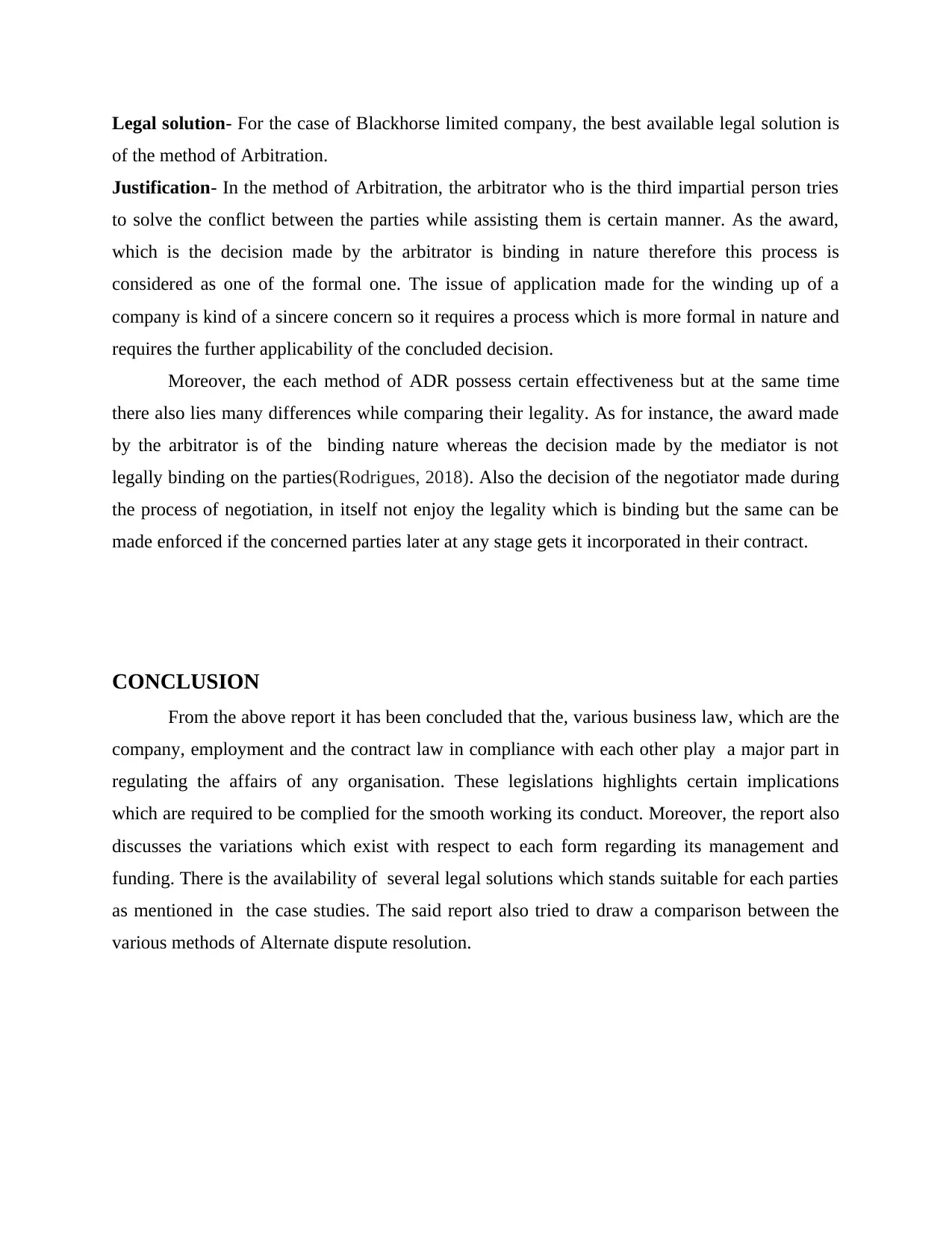
Legal solution- For the case of Blackhorse limited company, the best available legal solution is
of the method of Arbitration.
Justification- In the method of Arbitration, the arbitrator who is the third impartial person tries
to solve the conflict between the parties while assisting them is certain manner. As the award,
which is the decision made by the arbitrator is binding in nature therefore this process is
considered as one of the formal one. The issue of application made for the winding up of a
company is kind of a sincere concern so it requires a process which is more formal in nature and
requires the further applicability of the concluded decision.
Moreover, the each method of ADR possess certain effectiveness but at the same time
there also lies many differences while comparing their legality. As for instance, the award made
by the arbitrator is of the binding nature whereas the decision made by the mediator is not
legally binding on the parties(Rodrigues, 2018). Also the decision of the negotiator made during
the process of negotiation, in itself not enjoy the legality which is binding but the same can be
made enforced if the concerned parties later at any stage gets it incorporated in their contract.
CONCLUSION
From the above report it has been concluded that the, various business law, which are the
company, employment and the contract law in compliance with each other play a major part in
regulating the affairs of any organisation. These legislations highlights certain implications
which are required to be complied for the smooth working its conduct. Moreover, the report also
discusses the variations which exist with respect to each form regarding its management and
funding. There is the availability of several legal solutions which stands suitable for each parties
as mentioned in the case studies. The said report also tried to draw a comparison between the
various methods of Alternate dispute resolution.
of the method of Arbitration.
Justification- In the method of Arbitration, the arbitrator who is the third impartial person tries
to solve the conflict between the parties while assisting them is certain manner. As the award,
which is the decision made by the arbitrator is binding in nature therefore this process is
considered as one of the formal one. The issue of application made for the winding up of a
company is kind of a sincere concern so it requires a process which is more formal in nature and
requires the further applicability of the concluded decision.
Moreover, the each method of ADR possess certain effectiveness but at the same time
there also lies many differences while comparing their legality. As for instance, the award made
by the arbitrator is of the binding nature whereas the decision made by the mediator is not
legally binding on the parties(Rodrigues, 2018). Also the decision of the negotiator made during
the process of negotiation, in itself not enjoy the legality which is binding but the same can be
made enforced if the concerned parties later at any stage gets it incorporated in their contract.
CONCLUSION
From the above report it has been concluded that the, various business law, which are the
company, employment and the contract law in compliance with each other play a major part in
regulating the affairs of any organisation. These legislations highlights certain implications
which are required to be complied for the smooth working its conduct. Moreover, the report also
discusses the variations which exist with respect to each form regarding its management and
funding. There is the availability of several legal solutions which stands suitable for each parties
as mentioned in the case studies. The said report also tried to draw a comparison between the
various methods of Alternate dispute resolution.
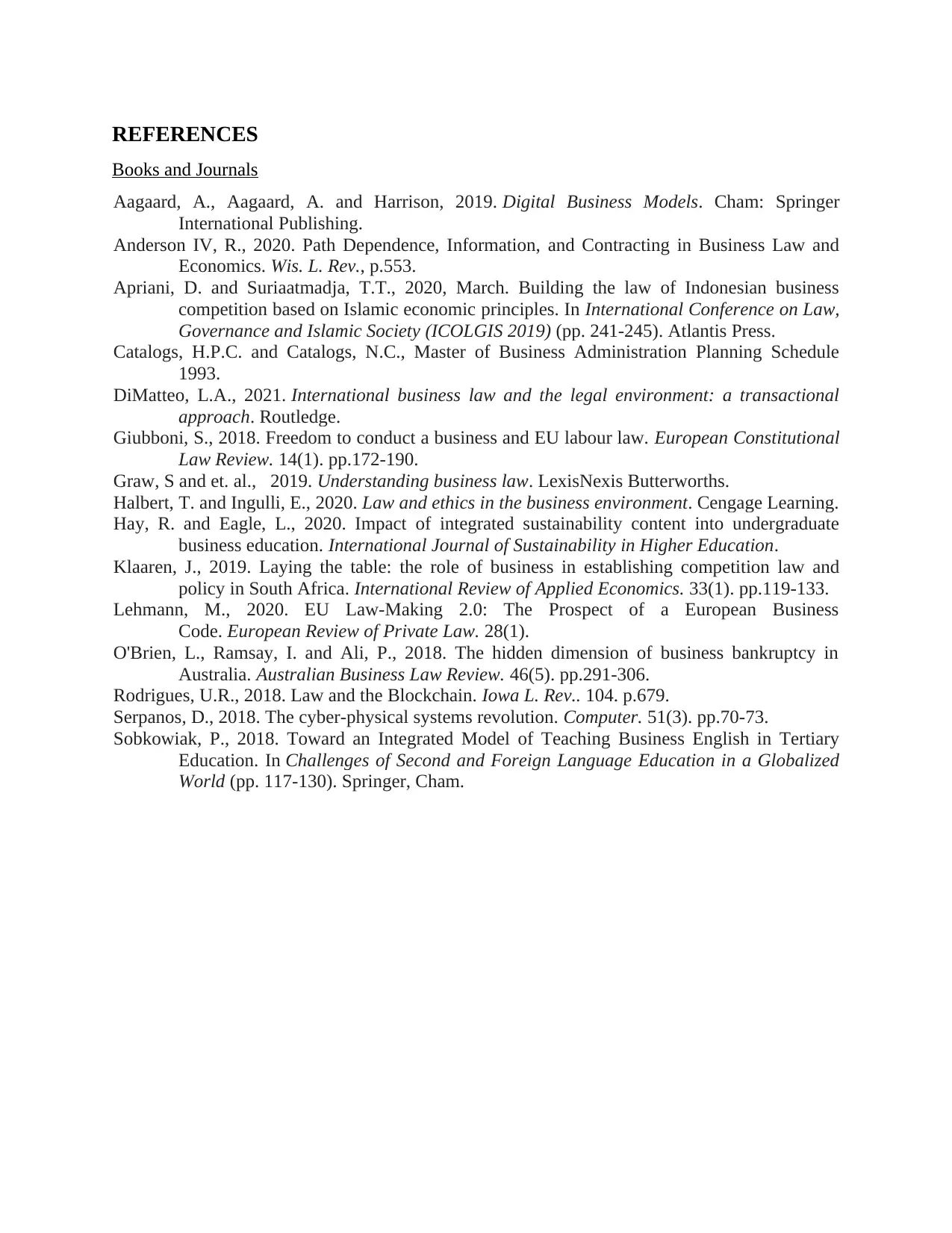
REFERENCES
Books and Journals
Aagaard, A., Aagaard, A. and Harrison, 2019. Digital Business Models. Cham: Springer
International Publishing.
Anderson IV, R., 2020. Path Dependence, Information, and Contracting in Business Law and
Economics. Wis. L. Rev., p.553.
Apriani, D. and Suriaatmadja, T.T., 2020, March. Building the law of Indonesian business
competition based on Islamic economic principles. In International Conference on Law,
Governance and Islamic Society (ICOLGIS 2019) (pp. 241-245). Atlantis Press.
Catalogs, H.P.C. and Catalogs, N.C., Master of Business Administration Planning Schedule
1993.
DiMatteo, L.A., 2021. International business law and the legal environment: a transactional
approach. Routledge.
Giubboni, S., 2018. Freedom to conduct a business and EU labour law. European Constitutional
Law Review. 14(1). pp.172-190.
Graw, S and et. al., 2019. Understanding business law. LexisNexis Butterworths.
Halbert, T. and Ingulli, E., 2020. Law and ethics in the business environment. Cengage Learning.
Hay, R. and Eagle, L., 2020. Impact of integrated sustainability content into undergraduate
business education. International Journal of Sustainability in Higher Education.
Klaaren, J., 2019. Laying the table: the role of business in establishing competition law and
policy in South Africa. International Review of Applied Economics. 33(1). pp.119-133.
Lehmann, M., 2020. EU Law-Making 2.0: The Prospect of a European Business
Code. European Review of Private Law. 28(1).
O'Brien, L., Ramsay, I. and Ali, P., 2018. The hidden dimension of business bankruptcy in
Australia. Australian Business Law Review. 46(5). pp.291-306.
Rodrigues, U.R., 2018. Law and the Blockchain. Iowa L. Rev.. 104. p.679.
Serpanos, D., 2018. The cyber-physical systems revolution. Computer. 51(3). pp.70-73.
Sobkowiak, P., 2018. Toward an Integrated Model of Teaching Business English in Tertiary
Education. In Challenges of Second and Foreign Language Education in a Globalized
World (pp. 117-130). Springer, Cham.
Books and Journals
Aagaard, A., Aagaard, A. and Harrison, 2019. Digital Business Models. Cham: Springer
International Publishing.
Anderson IV, R., 2020. Path Dependence, Information, and Contracting in Business Law and
Economics. Wis. L. Rev., p.553.
Apriani, D. and Suriaatmadja, T.T., 2020, March. Building the law of Indonesian business
competition based on Islamic economic principles. In International Conference on Law,
Governance and Islamic Society (ICOLGIS 2019) (pp. 241-245). Atlantis Press.
Catalogs, H.P.C. and Catalogs, N.C., Master of Business Administration Planning Schedule
1993.
DiMatteo, L.A., 2021. International business law and the legal environment: a transactional
approach. Routledge.
Giubboni, S., 2018. Freedom to conduct a business and EU labour law. European Constitutional
Law Review. 14(1). pp.172-190.
Graw, S and et. al., 2019. Understanding business law. LexisNexis Butterworths.
Halbert, T. and Ingulli, E., 2020. Law and ethics in the business environment. Cengage Learning.
Hay, R. and Eagle, L., 2020. Impact of integrated sustainability content into undergraduate
business education. International Journal of Sustainability in Higher Education.
Klaaren, J., 2019. Laying the table: the role of business in establishing competition law and
policy in South Africa. International Review of Applied Economics. 33(1). pp.119-133.
Lehmann, M., 2020. EU Law-Making 2.0: The Prospect of a European Business
Code. European Review of Private Law. 28(1).
O'Brien, L., Ramsay, I. and Ali, P., 2018. The hidden dimension of business bankruptcy in
Australia. Australian Business Law Review. 46(5). pp.291-306.
Rodrigues, U.R., 2018. Law and the Blockchain. Iowa L. Rev.. 104. p.679.
Serpanos, D., 2018. The cyber-physical systems revolution. Computer. 51(3). pp.70-73.
Sobkowiak, P., 2018. Toward an Integrated Model of Teaching Business English in Tertiary
Education. In Challenges of Second and Foreign Language Education in a Globalized
World (pp. 117-130). Springer, Cham.
1 out of 12
![[object Object]](/_next/static/media/star-bottom.7253800d.svg)



